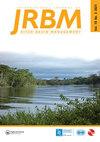印度喀拉拉邦Kallada河水质量指标的应用研究
IF 1.9
Q3 WATER RESOURCES
International Journal of River Basin Management
Pub Date : 2021-12-03
DOI:10.1080/15715124.2021.2002347
引用次数: 1
摘要
摘要:Kallada河发源于印度喀拉拉邦Sahyadri(西高止山脉)南部的Karimalai Kodakkal,流经Kollam、Pathanamthitta和Trivandrum地区。世界银行援助的喀拉拉邦最重要的灌溉项目之一以卡拉达河为中心,目前该项目已惠及92个村庄。然而,监测卡拉达河的水质是至关重要的。本研究的重点是使用毛翅目昆虫(caddisflies)以及水的物理化学参数来评估卡拉达河的水质。在季风前季节,从河流中的6个地点采集了球藻和水的样本,以监测水质。总共记录了属于5个不同分类群的3000多个标本。采用多元统计方法研究了水质对石蛾区系的影响。结果表明,上游支持群落丰度高于下游。分别在Punalur和West Kallada的中游和下游地区观察到较少的球藻。Koivila第六个地点没有尸体,这是由于Ashtamudy河口的盐水入侵和各种人为活动,如划船、市政污水和捕鱼。上游站点显示出良好的水质条件和丰富的球藻。卡拉达河受到人为干扰的威胁,尤其是在中下游河段。caddisfly组合被证明适用于识别Kallada河水质条件的变化,因为它们对环境波动有显著的响应。本文章由计算机程序翻译,如有差异,请以英文原文为准。
Utility of caddisflies (Insecta: Trichoptera) as indicators of water quality in Kallada River, Kerala, India
ABSTRACT The perennial Kallada River originates at Karimalai-Kodakkal in the Southern part of Sahyadri (Western Ghats), running through Kollam, Pathanamthitta, and Trivandrum districts of Kerala, India. One of the crucial World Bank aided and the most significant Irrigation projects in Kerala is centred on the Kallada River, and now this project is benefited for in 92 villages. However, it is essential to monitor the water quality of the Kallada River. The focus of the present study is to assess the water quality of the Kallada River using caddisflies (Trichoptera) as well as physicochemical parameters of water. Samples of caddisflies and water were collected from 6 sites in the river to monitor water quality during the pre-monsoon season. Altogether, more than 3000 specimens belonging to 5 different taxa were recorded. A multivariate statistical approach was applied to study the influences of the water quality on caddisflies fauna. The results indicate that the upstream supported community abundance than the downstream. Less abundance of caddisflies was observed in the midstream and downstream sites Punalur and West Kallada, respectively. Caddisflies were absent in the sixth site Koivila, resulting from saltwater intrusion from the Ashtamudy estuary and various anthropogenic activities such as boating, civic effluents, and fishing. Upstream sites showed good water quality conditions and caddisfly abundance. The Kallada River is under threat of anthropogenic disturbances, especially in the mid and downstream sections. The caddisfly assemblage proved to be suitable in identifying variations in water quality conditions in the Kallada River because of their significant responses to environmental fluctuations.
求助全文
通过发布文献求助,成功后即可免费获取论文全文。
去求助
来源期刊

International Journal of River Basin Management
WATER RESOURCES-
CiteScore
6.00
自引率
4.00%
发文量
48
期刊介绍:
include, but are not limited to new developments or applications in the following areas: AREAS OF INTEREST - integrated water resources management - watershed land use planning and management - spatial planning and management of floodplains - flood forecasting and flood risk management - drought forecasting and drought management - floodplain, river and estuarine restoration - climate change impact prediction and planning of remedial measures - management of mountain rivers - water quality management including non point source pollution - operation strategies for engineered river systems - maintenance strategies for river systems and for structures - project-affected-people and stakeholder participation - conservation of natural and cultural heritage
 求助内容:
求助内容: 应助结果提醒方式:
应助结果提醒方式:


